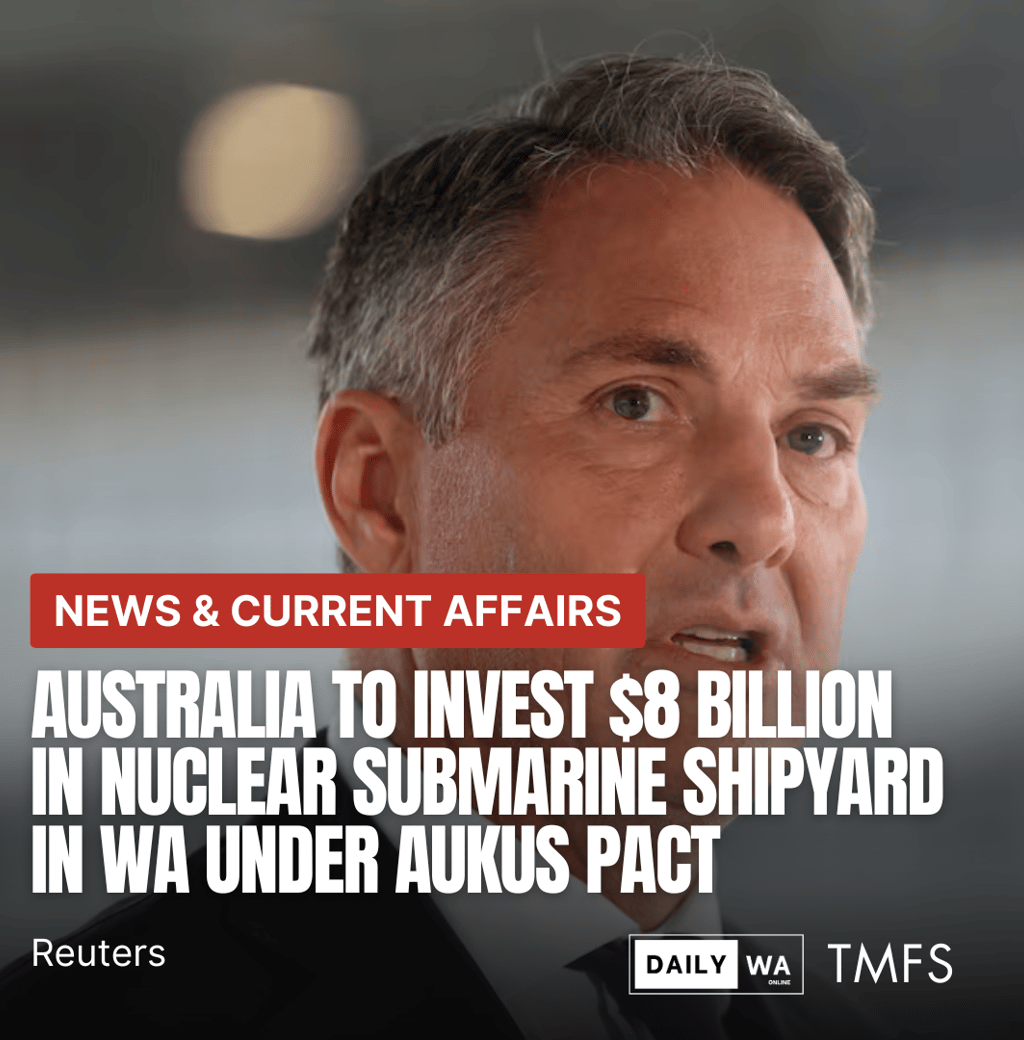Australia Anchors Future Defence in WA: $8 Billion Nuclear Submarine Shipyard to Transform AUKUS Ambitions
In a landmark move under the AUKUS security pact, Australia will invest $8 billion to build a nuclear submarine shipyard in Western Australia, cementing the state’s strategic role in Indo-Pacific defence and reshaping the nation’s industrial future.
NEWS & CURRENT AFFAIRS


Australia is set to embark on one of its most ambitious defence infrastructure projects yet — an $8 billion investment in a nuclear-powered submarine shipyard in Western Australia, announced under the framework of the AUKUS trilateral alliance with the United States and the United Kingdom.
This monumental project, revealed by Reuters, underscores Canberra’s commitment to enhancing sovereign capability and establishing a long-term industrial base for nuclear-powered submarines — a cornerstone of the AUKUS pact aimed at countering strategic threats in the Indo-Pacific.
For Western Australia, the investment represents more than a military milestone. It marks a transformational shift in the state’s economic and geopolitical standing — positioning Perth as a defence innovation hub and a central node in a global alliance designed for deterrence, interoperability and technological edge.
Building the backbone of AUKUS
The AUKUS agreement, signed in 2021, laid the foundation for a multi-decade plan to equip Australia with a fleet of nuclear-powered submarines. The new shipyard will play a pivotal role in this vision — serving as both a construction and maintenance facility for next-generation vessels expected to enter service from the late 2030s.
Located near HMAS Stirling, one of the Royal Australian Navy’s most critical assets, the shipyard will integrate cutting-edge nuclear infrastructure, advanced training centres, and defence supply chain networks.
Officials say the project will create thousands of local jobs, particularly in engineering, fabrication, nuclear technology, logistics, and systems integration. It also opens a pipeline for skills development partnerships with universities, TAFEs and private sector innovators.
“This is not just a defence investment,” said one senior official quoted in the report. “It’s a national capability-building exercise — one that will ripple across generations.”
Strategic stakes in the Indo-Pacific
Beyond industrial growth, the decision to anchor AUKUS operations in WA carries profound strategic implications.
Western Australia’s geographic proximity to the Indian Ocean and critical sea lanes of communication makes it a natural staging point for maritime security operations. As great-power competition intensifies across the Indo-Pacific — from the South China Sea to the Straits of Malacca — Australia’s west coast is poised to become a launchpad for regional deterrence and alliance cooperation.
Defence analysts say the shipyard will also strengthen interoperability between AUKUS partners by enabling joint maintenance, crew rotations and technology transfer. It will facilitate Australia’s gradual transition from a customer of security to a co-architect of deterrence, elevating its status within allied frameworks.
However, with opportunity comes responsibility. Operating nuclear-powered vessels demands stringent safety standards, regulatory oversight, and transparent community engagement. WA will need to balance its new strategic weight with careful governance to maintain public trust and environmental integrity.
Economic ripple effects and regional leadership
Economically, the $8 billion shipyard is expected to supercharge WA’s advanced manufacturing sector and diversify its industrial base beyond mining.
By embedding defence innovation within the state’s economic DNA, the initiative could create cross-sector synergies — fostering spin-offs in energy systems, robotics, AI, and marine science. Local suppliers, SMEs and startups will have opportunities to participate in AUKUS-linked contracts, driving a new wave of sovereign capability.
Yet the project also raises questions about workforce readiness and skills shortages. As WA competes with other sectors for engineering talent, coordinated policy between federal, state and industry stakeholders will be essential to ensure sustainable capacity building.
AUKUS: ambition, alignment, accountability
The AUKUS pact has always been more than a military compact; it is a technological alliance designed to preserve stability through shared innovation and deterrence. This shipyard is its physical embodiment — a tangible expression of Australia’s intent to stand as a pillar of Indo-Pacific security.
Still, as the price tag rises and timelines extend, the government will face scrutiny over cost control, transparency, and strategic return on investment. Critics argue that the funds could alternatively support domestic priorities like healthcare or climate adaptation. Proponents counter that security is the prerequisite for prosperity, and deterrence the cost of peace.
Western Australia’s new identity
For Western Australia, this investment is a defining moment — transforming it from a resource powerhouse into a strategic anchor of national defence. The state’s ports, industrial corridors, and engineering expertise will now serve not only global markets but the collective security of allied nations.
As construction begins, WA steps into a new chapter — one where its geography, economy and identity converge to shape the balance of power across the Indo-Pacific.
At TMFS, we view this milestone as more than a policy headline. It represents a shift in mindset — from extraction to creation, from isolation to integration. By anchoring AUKUS in the west, Australia affirms that defence, innovation and development are inseparable strands of national progress.
The $8 billion shipyard is not merely an investment in infrastructure.
It is an investment in Australia’s future sovereignty — and in the collective will to defend it.
All rights belong to their respective owners. This article contains references and insights based on publicly available information and sources. We do not claim ownership over any third-party content mentioned.
